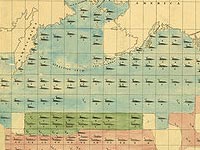
Lesson 1
World Geography: Making a Replica Map
- Time Required: 50 minutes
- Curriculum Fits: History, Geography
Lesson Overview
Using a world map of today and a historical whale chart from 1851, students will increase their understanding of world geography and demonstrate improved observation skills as they compare and contrast two kinds of maps. They will learn about whaling and the types of whales hunted during the golden age of whaling and create their own replica of a historic map.
Learning Objectives
- Students will be able to identify and label continents and oceans on a world map.
- Students will develop an understanding of historical maps and their purpose using a whale chart from 1851.
- Students will be able to identify a right whale and sperm whale.
- Students will state one reason why people went whaling in the 1800s.
Materials
- display-sized world map of today
- photocopies of individual blank world maps
- Making Your Own Map list of continents and oceans for students to cut/copy
- primary source: 1851 Whale Chart (printable display-sized 20" x 30" PDF - 42.4MB)
- student copies of 1851 Whale Chart
- teacher resource: Background Info: 1851 Whale Chart
- secondary source: Background Info: What Whalemen Hunted
- teacher resource: Background Info: Story of Whaling; Introduction on this website
- photocopies of Whale I.D. Cards
- student handout: Map Observations
- tea bags
- newspaper
- tub
Procedure
- Show students a world map of today and have them brainstorm what they know about maps. Next, give them each their own copy of a world map and a list of continents and oceans. Have students cut out geographical locations and glue them onto their map (or copy).
- Give each student a copy of the 1851 Whale Chart. Working in
pairs, have students answer key questions about the chart.
Map Observation Questions
- What do you notice about his map?
- What is being depicted in this map?
- Why would someone make this map?
- Who might use this map?
- Where do you think they got this information?
- Have students brainstorm on a class chart what they know, what they wonder, and what they want to find out about whales. Read to the class the backgorund information, What Whalemen Hunted. Guide a discussion that revolves around right whales and sperm whales and why they were hunted. Give students photocopies of right whales and sperm whales and have them cut and glue whales onto their maps. When the maps are finished, set up a tub of brewed black tea. Have the students put their maps in tub and then set them out on newspaper to dry. Voila! Students have their own replica of a Whale Chart.
Authors
Martha Stackpole, Lauren Keaney-Serpa, Elaine Barnett, Kristy Fletcher